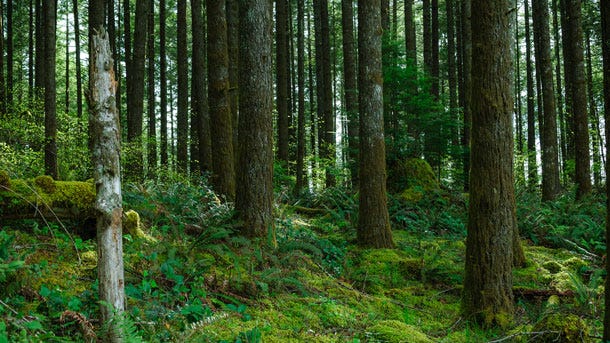Should you communicate your climate offsets?
The world of offsets has been in turmoil this week
Last week a news story broke across the Guardian’s front page. An investigation by the paper found that more than 90% of the carbon offsets verified by Verra (the standard for certifying carbon emissions reductions) did not actually reduce deforestation. This was terrible news for corporates and businesses across the board – many of whom had invested in offsetting schemes to try to reach their net zero targets.
I wanted to write a newsletter this week to explore how companies who have invested in carbon offsetting schemes should think about communicating them, now that they’ve reached peak bad press. The Voluntary Carbon Market is currently worth around $2bn (£1.6bn), and it has exploded over the past couple of years as companies scramble to look like they’re doing something to protect the climate.
What are carbon offsets?
Carbon offsets or credits have long been cynically viewed by environmentalists, who have described the schemes as a red herring. The message shared with consumers and members of the public is that it’s fine to consume and pollute, as long as you offset your emissions. This idea is exacerbated by some delivery companies who, before you press buy, ask if you’d like to spend £1.83 on offsetting your package so you can have your teak table delivered in a lorry guilt-free.
If only offsets really worked like this.
If only the earth had an accounting book that kept note of how many dollars had been pumped into an offsetting scheme and when it hit a certain figure decided to pull back on heating itself. In the words of Eco Act, a company that helps businesses achieve net zero and reduce their emissions, “Carbon offsetting is a mechanism used to finance greenhouse gas (GHG) emission reduction/avoidance or sequestration equivalent to the residual emissions of an organisation, business or territory beyond its value chain. This financing is achieved through the purchase of carbon credits.”
How do offsets work?
In layman’s terms – businesses spend money on carbon credits, and in return, trees or other ‘sequestering’ equivalents (objects that remove C02 from the atmosphere like trees or mangroves) are planted. They tend to be planted where land is cheap or where deforestation has occurred before, for example in Madagascar, or Mozambique or Naimbia. Brewdog also famously invested in a lot of tree planting in Scotland. But planting trees as a carbon offset scheme can be tricky:
they take time to grow and mature, and reach their full potential when it comes to sequestering C02.
They can be affected by pests and disease
They can be burned down in increasingly frequent wildfires
Illegal logging remains an issue
Forests need to have a permanence of 100 years to be effective carbon stores - that means planting today and not seeing carbon being removed from the atmosphere for another 100 years.
Sometimes the sheer number of trees promised (Shell has promised to plant more than five million trees in the Netherlands and Spain) leaves people scratching their heads and asking - is there enough space on this planet for all these trees?
And often, trees, or offsetting schemes occur in areas of the planet where there is less carbon emitted anyway.
That’s a really long list. It’s also just scraping the surface of reasons why investing in carbon offset schemes isn’t the panacea people assume. Evidence has been surfacing that hows how forced eviction of people who live on land earmarked for these planting schemes is on the rise. The Guardian was shown videos in Peru of people’s homes being cut down with chainsaws to make room for the tree-planting projects.
If they’re so problematic, why have businesses invested?
We live in a world where there aren’t many options for carbon removal - other than grounding all flights and stopping all fossil fuel extraction that is. Put bluntly, that ain’t gonna happen and nor would it be desirable for the majority of people for that to happen, either.
Future technologies such as carbon sequestering ‘plants’ are still just that - future projects. One carbon sequestering plant in Iceland - Climeworks - can remove around 4000 tons of C02 each year. This is a great start, but has been described by onlookers as ‘trying to bail out the Titanic with a teaspoon’.
It makes sense that businesses have jumped on services like carbon offsetting and buying carbon credits as a quick fix.
Should you still communicate your investments?
No single company has been hoodwinked or at fault here - apart from some of the companies selling overpriced offsets to desperate businesses. It’s long been recommended by some of the biggest players in the business, such as South Pole and Eco Act, to communicate about your offsets only when you have other tangible evidence of decarbonisation activities in place. This remains sage advice.
The Guardian investigation may affect businesses keenness to dive head-first into purchasing offsets, but not all offset schemes are bad.
If you choose to communicate your net zero goals publicly, make sure you’re doing more than simply purchasing offsets to achieve carbon neutrality. For example, you could be encouraging suppliers to use electric vehicles, or you might be starting a walk-to-work reward scheme for colleagues. Sometimes it’s the smaller things that go a longer way to transforming habits and creating change in the long-term.
Disclose your carbon footprint assessment. It’s important to know the full extent of your Scope 1, 2 and 3 emissions, so that you can publicly get a strategy in place to start reducing your emissions.
Be transparent and be honest. Own up the fact that you still have a long way to go on your net zero journey. There’s no point ‘winning’ and getting to net zero by 2030 if you’ve done it in name only with offsets rather than committed to real action. This is cheating, and it’s cheating the planet and future generations.
Be modest. This is a long journey. Acknowledge that we’re all just starting out and many companies are trying to do the best they can while learning as fast as they can too. Be kind, be thoughtful, and be modest. Unless your company is producing carbon sequestering machines made out of recycled tyres, you have nothing to brag about.
Be prepared to answer questions about future investments in these tree-building schemes. Will you continue to invest future pots of money into these schemes? Are there other technologies you could support or invest in instead?
Consider the fall-out if investment suddenly stops in Verra’s schemes. This shouldn’t be a reason to keep communicating all about your purchased carbon credits, but it goes without saying that if a significant amount of land has been cleared to plant trees, abandoned land is no greener.
For a more thorough run down of what your climate communication strategy could look like, Climate Seed’s step by step suggestions are very helpful.
Does anyone disagree with the problems behind carbon credits?
Lots of people.
Verra replied to the Guardian’s criticisms with a statement: “The main criticisms of Verra’s REDD+ methodologies cited in the article have already been addressed by a review that has been underway since 2021…project baselines are now re-assessed every six years rather than ten.” You can read the whole investigation and statement here.
In addition, the World Economic Forum has just published a blog about the importance of investing in high quality carbon credits - an interesting read, which centres around the fact that there is a marked improvement in independent monitoring and assessment of these schemes. Read more here.
Any fun news this week?
Thailand’s tuk-tuks look set to go green: demand for electric options for city transport on the rise. “The government has been encouraging EV uptake since 2015.”










Really informative post, I enjoyed reading this, thanks!